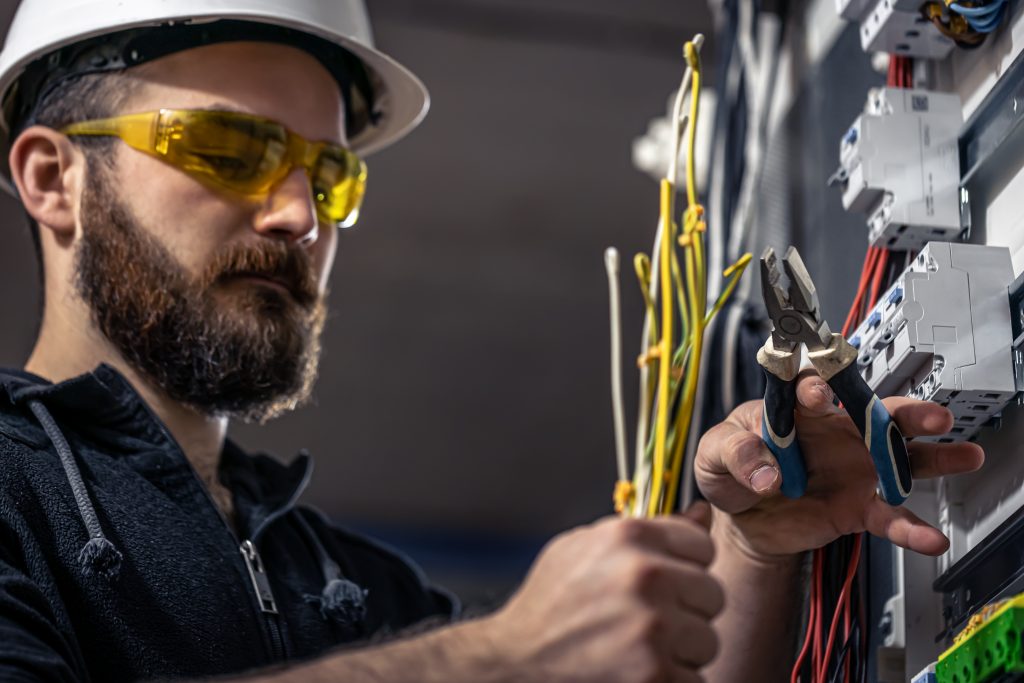
Choosing a career as an electrician can open the door to job security, steady income, and a satisfying hands-on profession. But once you’ve decided this is the path for you, the next question is: Should you go to trade school or start an apprenticeship?
Both routes can lead to a rewarding career in the electrical field, but they’re structured differently and appeal to different types of learners. In this article, we’ll break down how to become an electrician, compare trade school vs. apprenticeship, and help you decide which is the better fit for your goals.
What Does an Electrician Do?
Before diving into your training options, it helps to understand what electricians actually do. Electricians install, maintain, and repair electrical power systems in homes, businesses, and industrial settings. Their work can include:
- Installing wiring, outlets, circuit breakers, and lighting systems
- Reading blueprints and technical diagrams
- Troubleshooting electrical issues
- Following national and local electrical codes
- Working with tools, meters, and test equipment
The work is hands-on, technical, and often requires solving real-world problems on the spot. That’s part of what makes it appealing to people who enjoy practical tasks and dislike desk jobs.
Step-by-Step: How to Become an Electrician

No matter which path you take—trade school or apprenticeship—the steps to becoming a licensed electrician are fairly consistent. Here’s a more detailed look at what the journey usually involves:
1. Earn a High School Diploma or GED
This is the first requirement for any career in the electrical trades. A high school diploma or equivalent (like a GED) proves you have the basic math, reading, and critical thinking skills needed for the job. During high school, try to take classes in:
- Algebra and geometry (you’ll use math daily on the job)
- Physics or other science courses
- Shop class or basic electronics (if available)
These can give you a head start when you move on to formal training.
2. Choose Between Trade School or an Apprenticeship
This is the biggest decision you’ll make early on. Do you want to start with classroom-based education, or get straight into the field through hands-on learning? Your choice will determine the pace, structure, and cost of your training.
Not sure which to pick? Don’t worry—we’ll compare both in detail below.
3. Complete Classroom and/or On-the-Job Training
Regardless of your route, you’ll need a combination of theory and hands-on training. Trade school focuses on classroom instruction first, while apprenticeships blend on-the-job experience with part-time classes.
Both are designed to cover essential skills like:
- Electrical systems and safety
- Wiring and troubleshooting
- Code requirements and blueprint reading
Most states require a specific number of classroom hours and on-the-job hours to qualify for licensure.
4. Pass a Licensing Exam (If Required in Your State)
Licensing exams test your understanding of the National Electrical Code, electrical theory, and local regulations. You’ll also be tested on job safety and proper installation procedures. Passing the exam typically qualifies you as a journeyman electrician.
Each state has its own licensing process, so be sure to check with your local licensing board.
5. Start Working as a Journeyman Electrician
Once licensed, you can work independently on most types of electrical projects. Journeyman electricians earn higher pay than apprentices and can take on more responsibility. After a few years, you may even decide to pursue your master electrician license, which allows you to run your own business or oversee large projects.
What Is a Trade School for Electricians?
A trade school (also known as a technical college or vocational program) is a school designed specifically to teach job-ready skills. These programs are ideal for students who want a strong academic foundation before entering the workforce.
How Long Does Trade School Take?
Most electrician trade school programs take 9 months to 2 years to complete. Some offer accelerated options, while others include internships or externships with local employers.
What You’ll Learn in Trade School
Trade schools provide a structured curriculum covering:
- Electrical theory: How electricity works, types of circuits, and energy flow
- Safety procedures: OSHA standards, protective gear, and emergency responses
- Residential wiring: Installing outlets, light fixtures, and switches
- Commercial systems: Working with high-voltage panels and multi-phase systems
- Code compliance: National and local building codes
- Blueprint reading: Understanding technical diagrams and layout plans
- Tools and meters: Using voltage testers, conduit benders, multimeters, and more
Simulated Labs
Most programs include lab-based simulations, where students practice wiring mock rooms or panels in a safe, controlled setting. This hands-on exposure can help build your confidence before stepping onto an actual jobsite.
Program Credentials
Upon completion, you’ll typically receive a certificate, diploma, or associate degree—depending on the program and school.
What Is an Electrician Apprenticeship?
An apprenticeship is a structured program where you work as a paid employee under the supervision of a licensed electrician while attending classes on the side. It’s often considered the most direct and affordable path into the electrical trade.
How Long Do Apprenticeships Last?
Most apprenticeships last between 4 to 5 years. During that time, you’ll:
- Work 40+ hours per week
- Attend night classes or weekend sessions
- Get gradual raises as you gain experience
What You’ll Learn On the Job
As an apprentice, you’ll gain real-world knowledge by working on active job sites. You’ll learn:
- How to install, repair, and upgrade electrical systems
- Wiring for both residential and commercial projects
- How to safely use tools and heavy-duty equipment
- Interpreting blueprints and planning layouts
- Troubleshooting systems and solving problems on-site
Classroom Training
Apprentices are also required to complete classroom instruction during their program. These courses are often provided by unions, community colleges, or technical institutes. Topics typically include:
- Electrical codes and regulations
- Circuit theory and electronics
- Safety procedures and first aid
- Specialized systems (e.g., fire alarms, HVAC wiring)
Time Requirements
- 8,000 hours of on-the-job training
- 500–1,000 hours of classroom instruction
Program Sponsors
Apprenticeships are often run through:
- Unions (e.g., IBEW)
- Non-union trade associations (e.g., IEC)
- Electrical contractors or local businesses
Many programs don’t require tuition and even provide benefits like health insurance and paid holidays.
Trade School vs. Apprenticeship: Key Differences
Let’s take a deeper look at how trade schools and apprenticeships compare in major areas:
| Factor | Trade School | Apprenticeship |
| Time to Complete | 9 months to 2 years | 4 to 5 years |
| Upfront Cost | $5,000–$20,000, depending on school | Usually free or low-cost (sponsored by employers or unions) |
| Income While Training | None during school; income begins post-graduation | Earn a wage from day one |
| Learning Format | Structured classes, labs, exams | On-the-job learning + part-time classroom work |
| Hands-On Experience | Simulated practice in labs | Real-world job experience on construction and renovation sites |
| Credentials Earned | Certificate, diploma, or associate degree | Journeyman electrician license after passing licensing exam |
| Best For | Students who prefer school-based learning, structured pace | Hands-on learners ready to work in the field full time |
Is Trade School Worth It to Become an Electrician?
Yes—if you’re looking for a fast track to learning the technical side of the trade. Trade school is a solid choice if you want to:
- Build your knowledge base first before starting jobsite work
- Gain confidence in electrical theory and safety
- Improve your resume to qualify for future apprenticeships
- Enter the field quicker, especially if you’re not accepted into an apprenticeship yet
Just keep in mind: trade school doesn’t replace field experience. Most graduates still need to work as apprentices or assistants before becoming licensed.
Can You Become an Electrician Without Trade School?

Absolutely. In fact, many electricians skip trade school entirely and go straight into an apprenticeship. If you’re someone who:
- Learns best through hands-on work
- Doesn’t want student debt
- Wants to start earning right away
…then an apprenticeship is likely the better path for you.
Organizations Offering Apprenticeships:
- IBEW (International Brotherhood of Electrical Workers) – Union-based programs with great pay and benefits
- NECA (National Electrical Contractors Association) – Partnered with IBEW
- IEC (Independent Electrical Contractors) – Non-union option with nationwide reach
These organizations often have online application forms and annual openings. Some even offer pre-apprenticeship programs to help you prepare.
How to Find a Trade School or Apprenticeship Program
Your location and availability will shape your options, but here’s how to get started:
Finding a Trade School
- Search locally: Type “electrician trade school near me” into Google or Maps
- Use directories: Try TradeSchoolCareers.com or AccreditedSchoolsOnline.org
- Ask around: Contact local high schools, workforce centers, or career fairs for recommendations
- Check financial aid options: FAFSA, scholarships, or veterans benefits may help reduce costs
Finding an Apprenticeship
- Visit Apprenticeship.gov – The U.S. Department of Labor lists registered electrician programs by state
- Reach out to unions: Contact your local IBEW or NECA chapter
- Call local contractors: Some companies sponsor apprentices directly
- Attend job fairs or trade expos: Many employers and programs recruit on-site
What About Licensing and Certification?
Each state has different rules, but most require you to:
- Complete a minimum number of training hours (in school or as an apprentice)
- Pass a licensing exam, typically covering:
- Electrical theory
- The National Electrical Code
- Local building codes
- Safety regulations
Some states may also require ongoing education or license renewal every few years. Check with your state’s Department of Labor or licensing board for specific requirements.
Pros and Cons of Each Path
Here’s a quick summary of the advantages and disadvantages of both options:
Trade School Pros:
- Faster path to education
- Great for classroom learners
- May help land an apprenticeship later
- Degree or certificate upon completion
Trade School Cons:
- Upfront cost (can be high)
- No immediate income
- Still need hands-on training afterward
Apprenticeship Pros:
- Get paid while you learn
- Real jobsite experience
- Free or low-cost education
- Direct route to licensure
Apprenticeship Cons:
- Long-term commitment (4–5 years)
- Competitive application process
- Must juggle work and classes
Which Path Should You Choose?
That depends on your learning style, financial situation, and career goals.
You might prefer Trade School if:
- You want to learn electrical theory first
- You prefer structured classroom environments
- You’re not ready to commit to full-time work yet
You might prefer an Apprenticeship if:
- You want to earn money right away
- You learn best by doing
- You’re ready to jump into the field
Final Thoughts: No Wrong Way to Start
Whether you choose trade school or an apprenticeship, you’re investing in a career that’s in high demand across the country. The Bureau of Labor Statistics projects strong growth in the field, with thousands of job openings each year due to retirements and infrastructure upgrades.
The most important step? Start somewhere. Research local options, apply to programs, and take that first step toward a solid, rewarding career.
If you’re passionate about working with your hands, solving problems, and making a real impact in your community, becoming an electrician could be the perfect fit.
